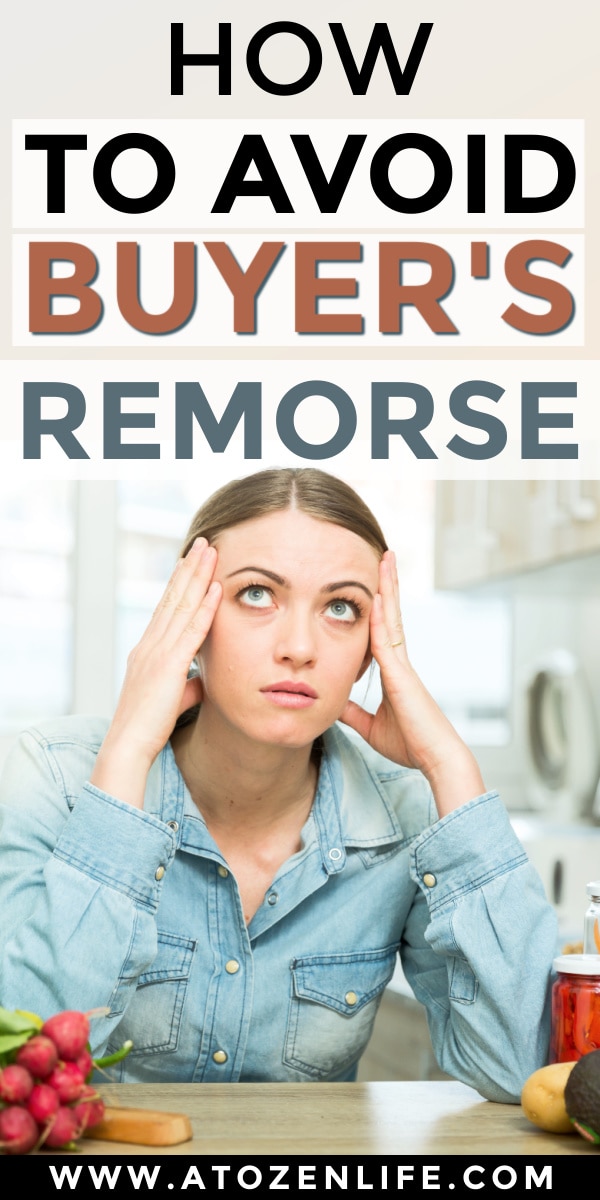What is Buyer’s Remorse and How Can You Avoid It?
This post may contain affiliate links for your convenience. That means that if you make a purchase, I will receive a small commission at no extra cost to you. Read more here.
Nobody wants to feel like they wasted their money, but unfortunately, many people experience buyer’s remorse after making a purchase. This is especially true when it comes to big-ticket items like cars, homes, and vacations.
In this blog post, you will find out what buyer’s remorse is, tips to help you avoid it in the future, and how to deal if you’re feeling buyer’s remorse right now.
This is a guest blog post by *drumroll* my husband!
Not only is he a CPA with over 20 years of accounting and finance experience, but he also has a lifetime of firsthand frugal living experience that comes along with growing up in third-world poverty, which you can read more about here.

What is buyer’s remorse?
Buyer’s remorse is a feeling of regret after having made a purchase. It is often accompanied by a sense of anxiety, shame, or guilt and can lead to second-guessing the decision.
It is more common with big-ticket purchases such as buying a car, luxury brand clothes, or a home. However, buyer’s remorse can happen with any purchase; you can read about the most common buyer’s remorse-inducing purchases that people tend to regret in this blog post.
As to why people experience regret after buying something, here are a few key reasons.
- They may not have done enough research on the product before making the purchase, only to realize afterward there were better options available.
- They might have made an impulsive decision and later realized it was not a wise choice.
- The item they bought is not what they expected it to be.
Is buyer’s remorse normal?
Buyer’s remorse is perfectly normal and happens to almost EVERYONE. According to Credit Donkey, it’s so common that only 5% of people say they never experience buyer’s remorse.
My worst personal buyer’s remorse experience was when we bought an SUV after having our first child. I had done a ton of research, read all the reviews on the car, and did comparison checks between dealerships and pricing.
I thought I had nailed it.
A month after making the purchase, I realized the car wasn’t what I expected. The car’s interior started to rattle, and my ears were drawn to the sound, trying to figure out what caused the rattling. For some reason, the dealership could not or did not want to find out why a brand new car would make rattling noises.
Every time I got into that car, I was reminded that I bought a lemon.
I start to question my decision-making abilities. If only I had waited a little longer until more statistics on quality and reliability were available or done more research.
The reality is that buyer’s remorse still exists even when you have done everything right. In which case, you need to make peace with yourself and move on with life, which I did.
Factors that affect the severity of buyer’s remorse
Many factors can contribute to buyer’s remorse, such as making a spur-of-the-moment purchase, being influenced by others, or succumbing to pressure from a salesperson.
However, the severity of remorse is heavily influenced by five factors.
5 Factors That Affect Buyer’s Remorse
- how much time went into researching and making the purchase
- how much money was spent
- how much emotion was involved in making the decision
- whether or not the purchase met the buyer’s expectation
- to what degree (qualitative and quantitative) was the alternative a better buy, in retrospect?
How to avoid buyer’s remorse?
Fortunately, you can do a few things to avoid buyer’s remorse.
By following these simple steps, you can improve your odds that your next purchase is one that you’ll be happy with for years to come.
Before making any big purchase, do your research. Know what you’re getting into, and be sure that it’s the right decision for you.
Don’t let anyone else pressure you into buying something you might regret.

1. Sticking to a budget
One of the best ways to avoid buyer’s remorse is to stick to a budget.
I would argue that a budget is the most effective tool to prevent overspending and the resulting buyer’s remorse.
A well-structured budget will account for every dollar you have available and make you think through every dollar spent in a given week, month, quarter, and year. You can track how you put your money to use and see the resulting returns, and every dollar is accounted for in the budget.
Find out how to create a budget and save more money in this blog post here.
2. Make a shopping list
Another great way to avoid buyer’s remorse is to make a shopping list.
When you have a specific item or items you need to purchase, write them down on a list. It will help you stick to a pre-defined game plan and buy only what you need, which reduces the chances of impulse buying.
If the item is not on the list, ask yourself if you really need it and can afford it.
READ MORE: 10 Tips to Stop Impulse Buying Crap You Don’t Need
3. Ask yourself why you need it
When debating a purchase, it’s essential to ask yourself why you need the item.
Do you need it for work? Is it a want or an actual necessity? Answering these questions will help you determine if the item is worth the investment.
If you’re still not sure, sleep on it.
Chances are you will cool down and realize you don’t need the item after all.
If you still want it, take the time to research an item before purchasing it. It means more than just reading reviews online (although that’s important, too).
You should also compare prices from different retailers and see if any coupons or promo codes are available. You’d be surprised how much money you can save by taking a few extra minutes to research an item.
4. Use the 30-Day Rule
On her YouTube channel, my wife teaches people minimalist shopping strategies for intentional spending, and one of the most popular and effective methods is the 30-Day rule. This helps curb emotional shopping to reduce the risk of buying something you regret.
Here’s how it works:
- find something you want to buy
- write the item down on a list – a note in your phone’s Notes app works great!
- wait for 30 days
- ask yourself if you still want the item – and why!
- if you still want it after 30 days, go ahead a buy
In her experience, 80% or more of the items on your list will end up being “nos” by the end of 30 days.
It’s a great way to avoid impulsive purchases, and it can also help you save money. If you really need something, chances are you’ll still have that need after 30 days.
But if you find that your desire for an item has faded, you’ve saved yourself money, clutter, and buyer’s remorse.
READ MORE: 7 Words to Practice Intentional Shopping (and Save Money Like a Minimalist)
5. Pay attention to your habits
No matter how careful you are, buyer’s remorse can still happen.
But when it does, pay attention to what went wrong. When you take the time to analyze your shopping habits that means you’ll be less likely to repeat the same mistakes again!
After all, those who don’t learn from history are doomed to repeat it!
READ MORE: 25 Frugal Minimalist Habits for a Rich and Happy Life
Need more help to stop buying stuff you regret?
Need more help with this? Grab this FREE top-rated budget planner printable to help get your money habits back on track!
Read more about the printables here:
- Download This FREE 2-Page Printable Budget Planner [PDF]
- How to Track Your Monthly Expenses [Free PDF]
What can you do when you have buyer’s remorse?
Are you suffering from buyer’s remorse? Don’t panic; you may have several options to reverse the transaction.
Let’s go through them one by one.
1. Check the return policy
If you’re struggling with buyer’s remorse, you should first check the store’s return policy.
Many stores will allow you to return items within a specific time frame, usually 30 days as long that the item is unused, the tag is still intact, and you have the receipt.
The return period can vary significantly from store to store. For instance, Apple only allows 14 days for the return from the date of purchase, while others allow up to 90 days for electronics. Also, certain stores will only exchange the item for in-store credit rather than giving you the money back.
Most stores should still allow a return without a receipt if the purchased item were paid with a credit card, as the information would still be available.
Some stores have a no questions asked policy, while others require that you state the reason for your return.
It’s best to familiarize yourself with each store’s return policy before you buy! It’ll save you a lot of headaches down the road.
2. Can you apply “The Cooling-Off Rule”
You may have heard about the Cooling-Off Rule.
In the United States, the rule gives you three days to cancel a contract for a purchase made in your home, workplace, dorm room, or at a seller’s temporary location, like a hotel room, apartment, car showroom, or boat show.
Many states offer their version of cooling down, which often extends the range of transactions.
For example, in Maryland and Massachusetts, you have up to seven days to cancel certain contracts.
In New York, the Cooling-Off Rule applies only to door-to-door sales. If you make a purchase at a store, you’re usually stuck with it.
The FTC website has more information about the federal Cooling-Off Rule.
3. Sell oR donating
What to do when you have kept your purchase past its return policy, or the store you bought from doesn’t accept returns?
One way to get your money back is to sell it.
Many options are available, such as selling it online (eBay, Facebook Marketplace, Letgo, etc.) or having a garage sale. If you can’t sell it, another option is to donate the item and record it for tax deduction.
The Salvation Army is a popular choice, but there are many other options, such as Goodwill or your local thrift store. Places like churches, schools, and women’s shelters all accept donations like this.
Donating has the added benefit of giving back to the community and passing the item to someone who might make good use of it. If you want to know more about these options, check out the blog posts below.
- I Made $50,000 Selling Clutter – Here’s How I Did It!
- 50+ Mindful Ways to Get Rid of Stuff You Don’t Want
- How to Sell on eBay: 20 Tips to Make the Most Money
4. Put things into perspective
When all options are exhausted, and you are stuck with the item, It’s important to remember that buyer’s remorse is often just a feeling and not reality. Finding the underlying reason for your remorse might help reveal that it’s not as big of a deal as you first thought.
In the grand scheme of things, there are many more important things in life to be grateful for than worrying about a purchase.
Buyer’s remorse is natural, but it’s important not to dwell on it for too long.
If you find that you are constantly succumbing to buyer’s remorse, it might be a good idea to take some time to evaluate your spending habits. There might be some underlying issues causing you to overspend or make impulsive decisions.
Buyer’s remorse is very typical, but it’s time to make changes when it’s constantly happening and negatively impacting your life.
Final Thoughts
Buyer’s remorse is a familiar feeling, and it doesn’t have to ruin your life. By being aware of it and taking the necessary steps to avoid it, you can make smarter spending decisions and live a happier life.
Hopefully, this guide has helped you understand buyer’s remorse a little better and given you some ideas to avoid it.
Do you have any tips for avoiding buyer’s remorse? Share them in the comments below.
Thanks for reading!
PIN THIS POST TO READ AGAIN!


Thanks, that was really helpful! The timing is also perfect, as I have time to return some items I’m not sure I really want or need, as well as forgive myself for, and finally deal with, old purchases that turned into clutter.
We all get that, Claudia – sounds like you are growing and learning. Forgiveness is key! Cheering you on.
Excellent Mr Zen!Thanks!
I’ll tell him for you, thanks Linda!